Friday night, I had the pleasure of attending WalkAustin’s first ever Happy Hour and meeting many wonderful people interested in making Austin more walkable, including many who work for municipal government. As this blog gets its name from the nexus of walking and activism, I’ll take this happy occasion to start setting out an agenda for improving walkability in Austin.
This is preliminary. I’d love feedback and filling in details! I’m covering a lot of issues I only know in passing. Also, this is an agenda for plausible things that would improve walkability. Some of them may conflict with other goals you have; that’s fine. Walkability isn’t the only goal in setting public policy.
Public Works
More Sidewalks
Much of the city is missing sidewalks, including some dense areas that would otherwise be good for walking. Adding sidewalks would provide safety and comfort for walkers.
Better Sidewalks
The Great Streets program has been doing wonders for walkability downtown, adding safety and comfort for walkers. This should not only be continued downtown, but be extended to selected other areas of the city.
More and Better Lighting
Even where there are sidewalks, many areas lack adequate street lighting, discouraging walkers due to safety reasons.
Better Grid Connectivity
Especially in South Austin, many streets fail to connect. This adds inconvenience for drivers, bicyclists, and pedestrians, as all must take circuitous routes, but it especially impacts pedestrians. A 1 mile detour adds 3 minutes to a drive, but 20 minutes to a walk. Take this walking route I just found by clicking around on google maps. In order to walk from one house to another without cutting through private property, neighbors whose back yards adjoin must walk 1.8 miles, or more than half hour, to cover a final distance of approximately 20 feet. This doesn’t just affect these two houses, but all residents on either side of this lack of a connection. I just found this situation by clicking on google maps, so perhaps there’s a walking easement not shown here, but there are plenty of these situations in Austin.
More Crosswalks
As a special case of grid connectivity, in some parts of the city, streets connect for cars, but due to the lack of crosswalks, they do not connect for pedestrians. As an example, I recently stayed at a rental apartment on Alpine St. near South Congress. Google maps advises me that walking to either Opal Divine’s or the Northbound 801 stop takes 2 minutes:
However, there is no crosswalk at South Congress across Alpine Street, not even one that only triggers when a pedestrian presses a button. In order to cross safely, and legally, I had to zoom out the map and walk about 12 minutes via the intersection of South Congress, Lightsey and Woodward.
For comparison, this is about time-equivalent to a driver having to drive an extra 5 miles at city speeds. Adding crosswalks at intersections such as these (especially across from bus stops!) would aid walkability considerably.
Fill out Crosswalks
Even where there are crosswalks, sometimes they have been designed in a way I have never experienced outside Austin, what I have come to call an “Austin crosswalk.” Instead of allowing one to cross a street directly, they are designed to force you to cross 3 times, waiting for the light each time. For example, at 29th and Guadalupe, there are crosswalks on the North, East, and West sides, forcing a pedestrian on the South side of 29th St. crossing to the South side of 29th to cross 29th to the North, then Guadalupe East or West, then 29th again back South:
Filling in the final crosswalk would make Austin more walkable.
Do a better job of Intermodal Pedestrian-Transit Connections
This was covered somewhat above in discussion of placing crosswalks near bus stops, but it also is true of, say, the Amtrak station. On Google Maps, Amtrak appears to be well-connected to 3rd and Lamar and the downtown grid:
However, zooming in reveals the pedestrian path Google has highlighted to be an unmarked, most likely illegal track crossing, not separated from automobile traffic:
Land Development Code
More density
With the exception of some cases listed above (areas without sidewalks, crosswalks, or grid connectivity), for the most part the number of destinations a given walker can reach within a given time is limited by the density of destinations. The more that the land use code allows for greater density (e.g. allowing taller buildings, greater ratio of usable floor space to footprint, smaller setbacks from the street), the more useful walking becomes. This is true at all scales, from downtown developments to small neighborhoods, although the greatest benefits will be seen in places where demand for large buildings is highest.
More density especially near already walkable areas
Obviously, this is a special case of “more density,” but it’s important to note: there are some areas where density would be especially useful to pedestrians. These are areas that are adjacent to other, already walkable areas like downtown or West Campus. The more people who are allowed to live in these areas with easy walks to destination-rich areas like West Campus or downtown, the more people who get to experience the solid walkability of Austin’s most walkable areas. As I said above, there are other reasons why some people might oppose this (e.g. in Judge’s Hill, people might prefer historical preservation to walkability), but from the perspective of walkability, dense areas in walking distance of walkable, destination-rich areas are very useful.
End parking minimums
A special case of density limitations is those imposed by the city requiring homes, businesses, and everything in between to provide parking. Obviously, those who walk to a destination do not use these parking spaces. Yet, they must pay the costs of these spaces being built in the form of higher rents or higher prices. These spaces limit the density that many developments reach because the cost of building structured parking or underground parking is so high that developers will build a building small enough that they can provide all required parking spaces on the surface or above.
More mixed use
People don’t just need to travel between random destinations; they frequently need to go from home to a business, whether it be a grocery store, restaurant, hardware store, office, etc. However, much of the zoning in the city is built on the premise of separating these uses out. This single usage zoning requires walkers to go longer distances to reach from the edge of the residential zone before they can reach many of their destinations. Encouraging greater mixed use would allow more shorter, walkable trips.
This could be accomplished by adding horizontal mixed use (i.e. different uses side-by-side) or vertical mixed use (i.e. residential on top of commercial in the same building). Some ways to allow these mixed uses would be:
- Add more acceptable light office uses (e.g. lawyers’ offices or other by-appointment style offices) to generally residential areas, allowing more people to work close enough to home to walk.
- Add more acceptable retail uses to selected corners in residential areas, allowing more people to walk to shop. For example: bodegas, small neighborhood restaurants, etc.
- Make it easier to build residences in commercial areas, whether they be vertical mixed use or horizontal.
Require new stores to orient themselves to the sidewalk
In many parts of Austin, store fronts are literally oriented toward parking and not toward pedestrians. Take the building which houses REI, Anthropologie, and Book People at 6th and Lamar. This is the view a pedestrian on 6th St has when next to the building:
Two locked service entrances (quite dirty when I walked by them this last week). The entrance to the stores are actually on the other side, oriented toward the parking lot:
The walk around the building itself isn’t unsafe, and is only mildly inconvenient for most who walk. However, it destroys some of the great joys of walking: window shopping and impulse purchases, and replaces them with an unsubtle message that this area is meant to be driven through, not walked in.
A lot of good work regarding this issue and the next has been done in the East Riverside Corridor plan.
Require new stores to place parking behind the store, not in front.
There are far too many examples to list here, everything from small neighborhood restaurants:
By requiring pedestrians to walk through parking areas, you create stress, danger, discomfort, and another unsubtle message that cars are more important than pedestrians. And yet, it would be easy for stores to be built so that drivers must drive behind the building in order to park. Again, the East Riverside Corridor plan has done good work on requiring stores to place stores between the pedestrian and the parking, instead of placing parking between the pedestrian and the store.
Conclusions
That’s my list for now! I’m sure there are many more, and I’d love to hear them (or disagreements with the ones I’ve got). This is a direction, not just an end goal, so walkability really comes in to play in a wide variety of different municipal policy decisions.

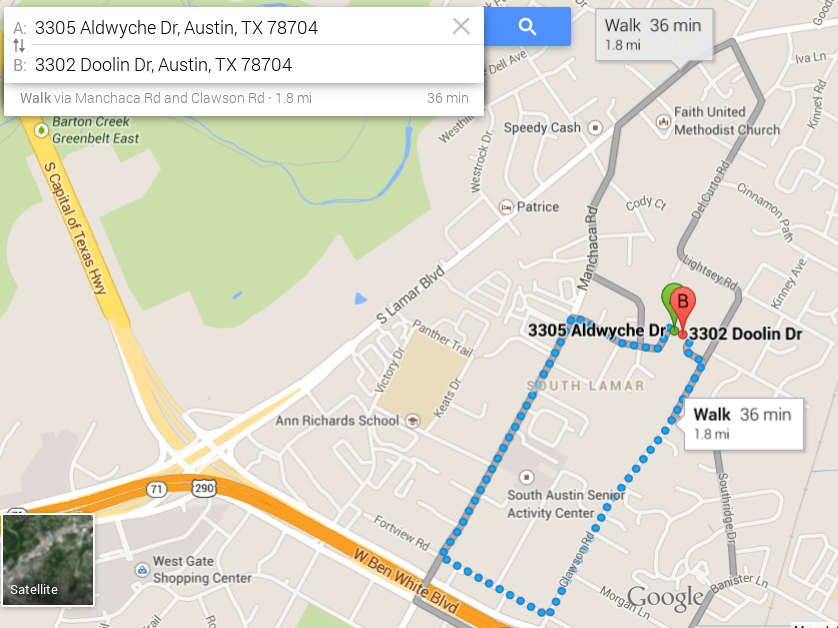

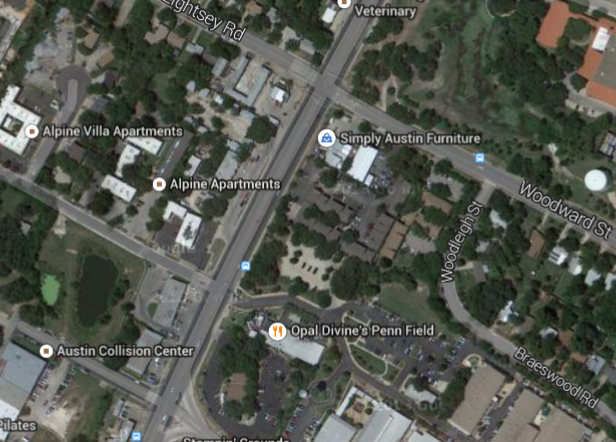
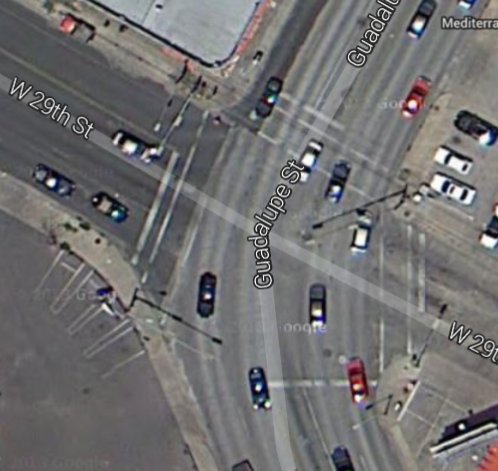
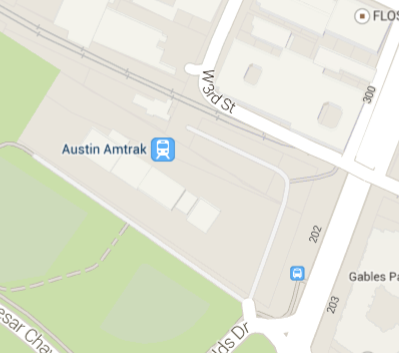


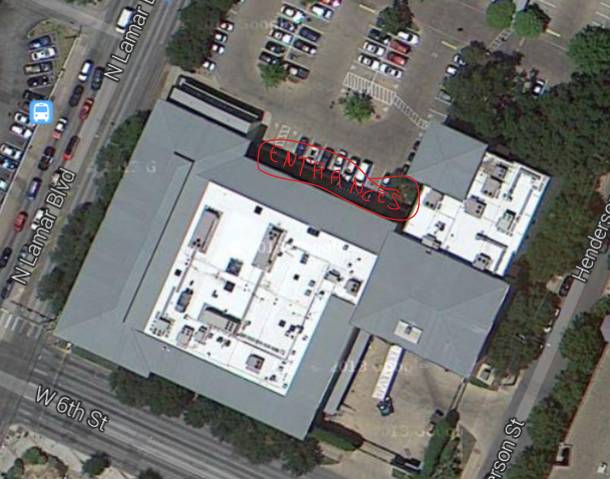

Some more items I forgot to mention:
* Turn the pilot program that allowed Royal Blue to lease the parking spaces in front of its Congress Ave location permanent, and allow any business to turn parking spaces into outdoor extensions of their business.
* Extend Public art and other placemaking tools.
Law enforcement:
* Public education and ticketing campaign to stop drivers from advancing into intersections when traffic prevents them from clearing the far crosswalk.
my vote goes to eliminating parking requirements 🙂
“However, there is no crosswalk at South Congress across Alpine Street, not even one that only triggers when a pedestrian presses a button. In order to cross safely, and legally”
I don’t believe this is strictly correct. My understanding is that pedestrians my legally cross here (it is considered an “unmarked crosswalk”). “safely” is a different matter.
http://www.austintexas.gov/sites/default/files/files/Police/PEST_flyer.pdf
http://d2dtl5nnlpfr0r.cloudfront.net/tti.tamu.edu/documents/2136-2.pdf
Huh! Awesome, I thought it was illegal. Now I know. I did make the crossing on my own, but when I had a less stupid friend with me, we walked the long way around. No way I would ever make that crossing with anybody younger than 15 or anybody in high-heeled shoes.
Thanks a lot for writing this up Dan. Too bad I did not know about the happy hour; it is right behind my office!
Novacek is right though I would mention that some blocks are incredibly long and I believe that if there is a marked crosswalk at the NEXT block down, you are supposed to cross there and NOT at the unmarked crosswalk.
Also, from the behavior of motorists I’ve seen in the U.S., most of them either don’t know about unmarked crosswalks or forget they exist. Only in the most pedestrian-friendly environment I’ve been to – Germany – did unmarked crosswalks actually work like they are “supposed” to. By contrast, in Korea, a MARKED crosswalk means “you CAN cross here” and you technically have the right-of-way but the de facto right of way belongs to oncoming motorists (so, basically like an unmarked crosswalk works here).
My wife and I have talked about this a lot. We both walk frequently in all parts of Austin (mostly central and Far Northwest, though also in near North, near Northeast, near West, etc.). I also walk to/from work, the gym, and some errands.
Lighting is a big issue for me, especially as we get into winter and it gets dark faster and faster. I’ve always thought that many neighborhoods (especially on the west side, both in and out of the city limits) have been crazy for wanting to be “twilight neighborhoods,” which I guess means keeping streetlights at a minimum. IIRC streetlights have a big impact on both crime itself as well as fear while walking – the less fear, the more walkers, the more OTHER walkers feel safe (“hey – many people are out walking, so it should be OK!”), and the less fear. It’s a virtuous circle.
Sidewalks are another important issue for me, especially given the prevalence of on-street parking, which forces street walkers to constantly adjust their walking trajectory in the absence of sidewalk. My wife especially absolutely hates walking in the street due to some highly-publicized vehicle-ped accidents such as Nestande. I still think it’s crazy that in Austin we have neighborhoods full of $500k+ homes with little or in some cases almost no sidewalks.
In many parts of the country it would be seen as ridiculous for an urban or semi-urban neighborhood, especially with such buoyant housing prices, to lack sidewalks on BOTH sides (e.g. Santa Monica, CA where there is stellar sidewalk coverage throughout the city). I was just in metro Tokyo, Japan – great place for pedestrians – and I love the wide sidewalks there on both sides of well-trafficked streets (wide sidewalks BUT zero other setback is quite pleasant).
As you mentioned, amenities especially retail locations is another walkability “feature” lacking in many areas. Last night my wife and I were in Rosedale and marveled that residents have not one, but two convenience stores/gas stations within easy walking distance on their side of Lamar. (And plenty more amenities as well.) Growing up in Far NW Austin, I always wished there were a corner/convenience store within the neighborhood, but from my parents’ house in the center of the neighborhood you have to travel a mile just to get to a convenience store. (That’s a mile of either homes or park/greenbelt.) There are several stores just at the 1.0-1.2-mile radius. Partly due to the parking-lot requirement and the political resistance to on-street parking, I can’t see the center of that neighborhood EVER getting zoned for any retail. I do think it is a decent location for a hybrid convenience store/gas station (2-4 pump) WITHOUT parking lot, as there is ample street parking in the area (but this will never happen).
So I totally agree with you that parking lot requirements are a barrier to walkability, both in the sense that 1) they create dead zones that add distance to any given trip and 2) the requirement prevents many small stores/retail buildings from ever opening in the first place, especially where land is either costly or otherwise difficult to assemble.
Also agree that density (FAR both on single-property + whole-neighborhood basis) and “separate” height restrictions (seems like 3 stories/60 ft is the norm?) are bad for walkability. A key driver in the high walkability of Japan and many areas of Germany is the prevalence of midrise (4-6 stories) in these countries’ metro areas. Midrise is also more “do-able,” both politically and logistically, without parking superstructures (above or below ground) and thus easier to add in significant amounts to a city than highrises. This is especially true if multiple parking spaces aren’t simply given out with rental, but rented/purchased separately (this seems to have the effect of decreasing overall resident parking needs). E.g. see http://www.mapc.org/resources/parking-toolkit/strategies-topic/unbundled-parking
Unbundled parking in general should also increase the number of people relying on foot/bike/transit significantly, meaning more locations catering to foot traffic in addition to those arriving by auto.
In many countries where large grocery stores draw from both foot and auto traffic – Korea and Brazil to name 2 I’ve experienced recently – entrances with registers on multiple sides of the building is seen as the norm, to cater to both shoppers who use the official (often garage) parking as well as shoppers who come on bike/foot on a sidewalk. In addition, smaller supermarkets in these countries are not expected to provide lots to customers; instead, customers park in the street nearby or (more common) simply walk, bike, or take the bus. Again, something of a chicken/egg problem – many valid defenses of the Mueller HEB said “multiple sides w/entrances is not the ‘HEB blueprint'” and “HEB knows the truth: few walkers/bikers will go there.” However, if the demand were there – enough residences near a store – and if the parking requirements are gone, the market will eventually provide (hence the Royal Blues downtown). In Brazil and Korea, though, neighborhoods with many midrises or short highrises usually have the most vibrant + closest neighborhood supermarkets; I do not think this is a coincidence.
A final point of accord: I agree that the ped connectivity in the Amtrak/Gables/YMCA area (south of 5th, north of Cesar Chavez, both sides of N Lamar) is absolutely a shambles. I walk there pretty often and sometimes illegally cross the railroad tracks at said crossing. To the east, there is not even a real way to get from the Cesar Chavez area up to 3rd street between the east side of Lamar + San Antonio; Gables (or Union Pacific?) even locks the stairs that could connect the east side of Lamar with the railroad tracks above (likely because crossing the tracks would be illegal). Hopefully the new Seaholm project will somehow make this better; however, for the time being the railroad tracks + hill/fence make walking in that area somewhat difficult, especially legally. I think in the long term, the City has plans to make the grid there significantly better; the future can’t come soon enough in this and many other cases around town.
A few years out of date, but still germane:
http://www.ci.austin.tx.us/publicworks/downloads/sidewalk_mp_resolution.pdf
The map on page 24 is especially interesting. As is the estimate for total build out (824 Million). I think the city is slowly making progress, doing what it can with limited resources. I’ve definitely seen some of the red areas of the map get new sidewalks (northbound Burnet south of 183, for instance).
For background, one of the resolutions that came from my time on the UTC that actually made it into law was a requirement that sidewalks must be added to a street during major reconstruction, unless it’s determined they would add more than 20% to overall project cost. (This was mainly Tommy Eden’s thing but I helped put a sheen of driver-respectability on it with the council at the time).
Baking sidewalks into other projects like that is a start – it’s no substitute for just doing the right thing all the time, but it made a lot of sense because when you’re tearing up the road already, why not fix it for everybody at the same time?
I’m not sure the current UTC keeps their eye on this ordinance. I did let Jace know about it once or twice.
In regards to the 29th/Guad intersection, I don’t know, but I wonder if the odd layout of the intersection is responsible. There may be visibility concerns with having a crosswalk on the southern end, since the road approaches at an angle/curve.
Yeah, it’s an odd intersection for a number of reasons. Crossing Nueces where it merges with Guadalupe is also very difficult because it becomes so wide (as is the southern edge of the intersection in question), and there’s an odd lack of crosswalks on Guadalupe south of the merger as well. I’m not sure how it could be reengineered better for pedestrians, but I bet it could be done.
Thank you Mike. I am surprised that sidewalks could ever add 20% to overall project cost if there is truly a major reconstruction.
That’s the logic we used. There was an original resolution which the 100% car guys on the UTC were nervous about because it didn’t include any cost provision. 20% matched the Federal policy at the time with one of the small buckets of CAMPO money (if I remember correctly) – so it was a natural choice, and we figured it would be difficult for sidewalks to ever cost more than that on any street being reconstructed (full-depth reconstruction, i.e. where they go down to the dirt).